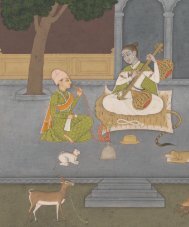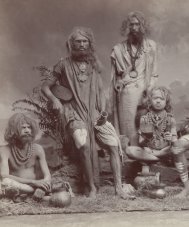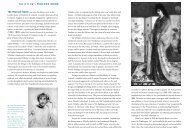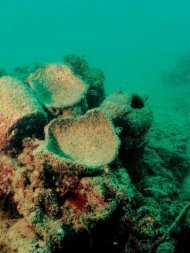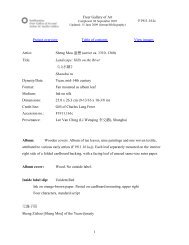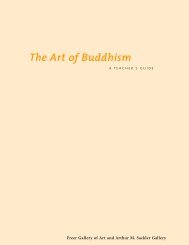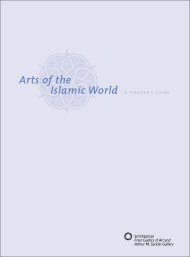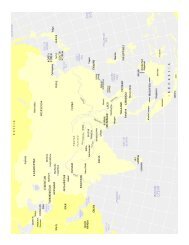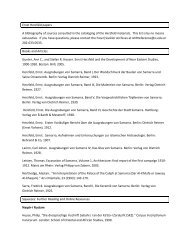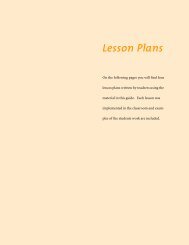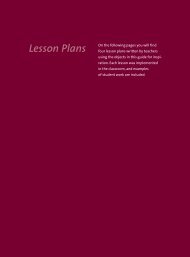Documentation - Smithsonian Institution
Documentation - Smithsonian Institution
Documentation - Smithsonian Institution
You also want an ePaper? Increase the reach of your titles
YUMPU automatically turns print PDFs into web optimized ePapers that Google loves.
Freer Gallery of Art<br />
Completed: 23 December 2007<br />
Last updated: 06 May 2010<br />
1<br />
F1960.1<br />
Project overview Table of contents View images<br />
Artist: Fanlong 梵隆 (active mid-12th century)<br />
Title: Sixteen Luohan<br />
《十六應真圖 》<br />
Shiliu yingzhen tu<br />
Dynasty/Date: Southern Song, mid-12th century<br />
Format: Handscroll<br />
Medium: Ink on paper<br />
Dimensions: 30.5 x 1062.5 cm (12 x 418-3/8 in)<br />
Credit line: Purchase<br />
Accession no.: F1960.1<br />
Provenance: C. C. Wang (Wang Jiqian 王季遷, 1907–2003), New York<br />
Fastening pin: Plain green jade<br />
Outside label: Ding Yan 丁晏 (1794–1876)<br />
Twelve characters, standard script.<br />
宋梵隆《十六應真圖》卷。丁晏題。<br />
Sixteen Luohan, handscroll by Fanlong of the Song dynasty. Written by Ding Yan.<br />
Mounting silk 1: Before frontispiece. Beige color, phoenix-and-cloud pattern. Mounted with<br />
inside label.
Freer Gallery of Art<br />
Completed: 23 December 2007<br />
Last updated: 06 May 2010<br />
Inside label: Chu Deyi 褚德彝 (1871–1942)<br />
Fourteen characters, clerical script<br />
宋梵隆《十六應真圖》卷。松窗審定題。<br />
2<br />
F1960.1<br />
Sixteen Luohan, handscroll by Fanlong of the Song dynasty. Authenticated by Songchuang [Chu<br />
Deyi].<br />
Frontispiece: One sheeet of ahuajian 砑花箋 paper; design of pines, cranes, and water. 1<br />
Dimensions: 30.5 x 120.3 cm (12-1/16 x 47-3/16 in)<br />
Mounting silk 2: Following frontispiece and before painting. Beige color, phoenix-and-<br />
cloud pattern.<br />
Painting description: Twelve sheets of white paper, varying widths.<br />
Dimensions: 1. W 50.9 cm (23-1/4 in)<br />
2. W 80.3 cm (32-11/16 in)<br />
3. W 97.0 cm (38-1/4 in)<br />
4. W 90.3 cm (35-1/2 in)<br />
5. W 75.1 cm (29-1/2 in)<br />
6. W 86.0 cm (33-7/8 in)<br />
7. W 100.2 cm (39-1/2 in)<br />
8. W 101.2 cm (39-13/16 in)<br />
9. W 86.8 cm (34-1/8 in)<br />
10. W 86.3 cm (33-15/16 in)<br />
11. W 100.9 cm (39-3/4 in)
12. W 96.9 cm (38-1/8 in)<br />
Freer Gallery of Art<br />
Completed: 23 December 2007<br />
Last updated: 06 May 2010<br />
3<br />
F1960.1<br />
Artist Inscription: Signature, located among rocks above water to right of luohan with tiger;<br />
very faint<br />
Signature: 梵隆敬寫<br />
Date: none<br />
Seals: none<br />
Respectfully drawn by Fanlong<br />
Colophons: (5) – Written on four sheets of paper; three mounted continously after<br />
painting and bearing four colophons, followed by mounting silk 3; and one sheet mounted<br />
separately bearing one colophon, followed by mounting silk 4.<br />
1. Zhongfeng Mingben 中峰明本 (1263–1325) 2<br />
Ink on one sheet of brown paper. Dimensions: W 63.3 cm (24-7/8 in)<br />
21 columns, “willow-leaf” running script<br />
住世應真十八開士,各以所證三昧,現種種奇異、種種境界,其神通變化,妙用罔測。惟<br />
見峩峩高山,青矗天岸,沈沈碧海,雪漲晴空,老樹新篁,蒼松恠石,后妃士女之敬肅,<br />
地神野卒之参隨,長蛇飲氣而毒燄自消,猛虎受降而威風自泯,踞坐示有餘之態,經行垂<br />
不盡之儀,使人一展卷間,不覺置身於石梁方廣。聞教有言,「外現聲聞身,內祕菩薩<br />
行」,且「外現」已竟,所謂「內祕」者,還属見聞也,無妨為說偈曰;
Freer Gallery of Art<br />
Completed: 23 December 2007<br />
Last updated: 06 May 2010<br />
奇形恠狀絕羅籠,達境惟心事事同,一十八人消息外,難將豪楮畫虛空。<br />
4<br />
F1960.1<br />
老辯提點行篋中藏此軸,一日禪暇舉似,命為着語,以題于后。西天目山幻住老頭陀明本<br />
敬書。<br />
[SDA- draft translation]<br />
Each of the Eighteen Yingzhen [Luohan] Who Respond to the Truth and Reside in the World, by<br />
virtue of his own enlightened Samadhi, manifests every kind of rare and extraordinary [quality]<br />
on every state and plane [of existence], as his supernatural powers transform and mutate,<br />
possessing marvelous functions without limit. See the lofty mountains, tall and towering, whose<br />
green [mass] thrusts to the shores of heaven, and the emerald sea, deep and gaping, whose snow-<br />
capped billows glisten in the void; [where among] the ancient trees and new bamboo, verdant<br />
pines and strange stones, [luohan receive] the respectful homage of empresses and lady officials,<br />
or are assisted by an entourage of earth spirits and field imps, and whether a great serpent is<br />
holding its breath until its poisonous flames extinguish themselves, or a fierce tiger is submitting<br />
to them while its ferocity naturally dissipates, they sit with folded legs exhibiting a relaxed<br />
demeanor, or move about displaying an ineffable dignity, causing one the instant he opens the<br />
scroll to unconsciously find himself there upon the Stone Bridge at Fangguang [Temple]. 3 I have<br />
heard the teaching which says: “Outwardly reveal the body of a śrāvaka; inwardly conceal the<br />
conduct of a bodhisattva,” but as the “outward revealing” [of their forms] is already completed<br />
[in this painting], and you may have an inkling about what is meant by “inwardly concealed,”<br />
there’s no harm if I explain it to you in a gatha, which says:<br />
Strange in form and shape, parted from the silken cage,<br />
In the state of only-mind, one to next is all the same.<br />
Aside from news that is reported of these eighteen men,<br />
One cannot use brush and paper to paint the empty void.
Freer Gallery of Art<br />
Completed: 23 December 2007<br />
Last updated: 06 May 2010<br />
5<br />
F1960.1<br />
The Superintendent Laobian keeps this scroll in his luggage, and one day during in a break from<br />
meditation he raised it and commanded me to put some words together and inscribe them at its<br />
end. The Old Ascetic of the Abode of Illusion on West Tianmu Mountain, [Zhongfeng] Mingben.<br />
Signature: 幻住老頭陀明本<br />
Date: none<br />
Seals: none<br />
The Old Ascetic of the Abode of Illusion [Zhongfeng] Mingben<br />
2. Tiechuan jushi 鐵船居士 (late 13th–early 14th century?) – unidentified<br />
Ink on one sheet of white paper. Dimensions: W 52.9 cm (20-13/16 in)<br />
8 columns, running-standard script<br />
十六声聞,遊戲神通,向一毫端,較絲來線去,隨形逐影,尚有這箇,在明眼人前,八字<br />
打開,一見便見,雖然不知見箇甚麼。付之一默。鐵船居士為一默上人書。<br />
[SDA- draft translation]<br />
The Sixteen Śrāvaka amusing themselves with supernatural powers toward the tip of a single<br />
hair, but if compared with [a line] coming and going like a silken thread following after form and<br />
shadow, then there is still this, that if one prepares a horoscope before a clear-eyed person, he<br />
will see it all in a single glance, even though he does not know what he is seeing. Sent to Yimo.<br />
Written by Tiechuan jushi [Retired Gentleman Iron Boat] for the Buddhist monk, Yimo.<br />
Signature: 鐵船居士<br />
Tiechuan jushi [Retired Gentleman Iron Boat]
Date: none<br />
Seals: (2)<br />
Freer Gallery of Art<br />
Completed: 23 December 2007<br />
Last updated: 06 May 2010<br />
Koujia biesheng『口加另生』(square relief) 4<br />
Tiechuan『鐵船』(square relief)<br />
3. Yuansou Xingduan 元叟行端 (1255–1341)<br />
Ink on one sheet of same white paper. Dimensions: W 51.7 cm (20-3/8 in)<br />
8 columns, clerical-standard script<br />
6<br />
F1960.1<br />
此十六大士,佛世比丘也。歷劫為其壽命,神通遊戲,飛行水陸,特餘事耳。畫師以筆端<br />
如幻三昧,幻出種種形相,譬猶取聲,安置篋中,其可認為實耶?延祐叶洽佛誕,陼西老<br />
謬行端。<br />
[SDA- draft translation]<br />
These Sixteen Mahasattva are ordained monks from the time of Buddha. Consecutive kalpas are<br />
the span of their lives, but amusing themselves with supernatural powers, flying over land and<br />
sea, these are are merely a trivial matter. By the magical samadhi of his brush tip, the painter<br />
magically produced all their sundry forms and features, as if one can actually hear their voices.<br />
Putting them away in your luggage, can they be considered real? [Written on] Buddha’s birthday<br />
[eighth day of the second lunar-month] in the xiexia [or wei] year of the Yanyou reign period<br />
[February 28, 1319], the Old Blunderer of Isle West [Yuansou] Xingduan.<br />
Signature: 陼西老謬行端<br />
Zhexi laoliao Xingduan
Date: 延祐叶洽佛誕<br />
Seals: (2)<br />
4. Dong Qichang 董其昌 (1555–1636)<br />
Freer Gallery of Art<br />
Completed: 23 December 2007<br />
Last updated: 06 May 2010<br />
7<br />
F1960.1<br />
Buddha’s birthday (eighth day of second lunar month), in the xiexia year<br />
[wei] of the Yanyou reign period [February 28, 1319]<br />
Yuansou『元叟』(square relief) – over signature<br />
Han Shi liren『寒拾里人』(square intaglio)<br />
Same sheet of paper as colophon 3, left side<br />
2 columns, standard script<br />
天啟三年歲在癸亥又十月朔,觀於武丘舟次。董其昌<br />
Viewed at the Wuqiu marina [near Suzhou], on the first day of the second [i.e., intercalary] tenth<br />
lunar month, with the year-star in guihai, third year of the Tianqi reign period [November 22,<br />
1623]. Dong Qichang.<br />
Signature: 董其昌<br />
Dong Qichang<br />
Date: 天啟三年歲在癸亥又十月朔<br />
First day of the second [i.e., intercalary] tenth lunar month in guihai, the<br />
third year in the Tianqi reign period [November 22, 1623].
Seals: (2)<br />
Freer Gallery of Art<br />
Completed: 23 December 2007<br />
Last updated: 06 May 2010<br />
Dong Qichang yin『董其昌印』(square intaglio)<br />
Zuanxiu liangchao shilu『纂修兩朝實錄』(rectangle intaglio)<br />
8<br />
F1960.1<br />
Mounting silk 3: Following colophon 4 and before colophon 5. Beige color, phoenix-and-<br />
cloud pattern.<br />
5. Lu Shihua 陸時化 (1714–1789)<br />
Ink on one sheet of separately mounted tan paper. Dimensions: W 24.3 cm (9-9/16 in)<br />
6 columns, running-standard script<br />
此宋僧梵隆《應真現相圖》,向與《十六羅漢渡水卷》並重于江淛間。《渡水卷》為高詹<br />
士澹人所藏;乃絹本,似遜於此卷。梵隆字茂宗,居吳興之菁山,高宗最雅愛之。癸巳重<br />
九日,聽松山人陸時化。<br />
This is is the picture Manifestations of Luohan by the monk Fanlong of the Song dynasty. In the<br />
past, it was held in equal esteem throughout the Jiangsu-Zhejiang area with his handscroll Sixteen<br />
Luohan Crossing the Water. Crossing the Water was in the collection of the Supervisor of the<br />
Household of the Heir Apparent, Gao Danren [Gao Shiqi, 1645–1703], and while done on silk, it<br />
seems inferior to this scroll in execution. Fanlong’s courtesy name was Maozong and he lived on<br />
Mount Jing in Wuxing, and was much admired by Emperor Gaozong [reigned 1127–63]. Ninth<br />
day of the ninth lunar-month in the guisi year [October 24, 1773], Lu Shihua, the Mountain Man<br />
Listening to Pines.<br />
Signature: 聽松山人陸時化
Date: 癸巳重九日<br />
Seals: (3)<br />
Freer Gallery of Art<br />
Completed: 23 December 2007<br />
Last updated: 06 May 2010<br />
9<br />
F1960.1<br />
Ninth day of the ninth lunar-month in the guisi year [October 24, 1773]<br />
Wuxia liulang『吳下六郎』(rectangle relief) – upper right<br />
Lu Shihua yin『陸時化印』(square intaglio) – following signature<br />
Runzhi『潤之』(square relief) – following signature<br />
Mounting silk 4: Following colophon 5. Beige color, phoenix-and-cloud pattern.<br />
Collector seals: (33)<br />
1. Lu Shihua 陸時化 (1714–1779) – (4)<br />
Lu Runzhi cang『陸潤之藏』(square relief) – painting, lower right edge<br />
Taicang Lu Runzhi yin『太倉陸潤之印』(rectangle relief) – painting, lower left edge<br />
Loudong Lu shi jianshang『婁東陸氏鑒賞』(rectangle relief) – colophon 1, center top<br />
Runzhi suo cang『潤之所藏』(rectangle relief) – colophon 2, upper right<br />
2. Zhao Liewen 趙烈文 (1832–1893) – (1)<br />
Nengjing jingyan『能靜經眼』(rectangle relief) – painting, mid left edge<br />
3. Zong Yuanhan 宗源翰 (1834–1897) – (3)
Freer Gallery of Art<br />
Completed: 23 December 2007<br />
Last updated: 06 May 2010<br />
10<br />
F1960.1<br />
Zong Xiangwen zhencang yin『宗湘文珍藏印』(rectangle relief) – painting, lower left edge<br />
Yiqingguan zhu『頤情館主』(square intaglio) – colophon 1, upper right<br />
Yiqingguan『頤情館』(oval relief) – colophon 3, upper right<br />
4. Jin Chuansheng 金傳聲 (mid-19th–early 20th cent.) – (4)<br />
Xiushui Jin shi Lanpo guomu『秀水金氏蘭坡過目』(rectangle relief) – painting, lower right edge<br />
Jin Chuansheng『金傳聲』(square intaglio) – colophon 1, lower right corner – (1/2)<br />
Jin Chuansheng『金傳聲』(square intaglio) – colophon 4, lower left corner – (2/2)<br />
Xiushui Jin Lanpo souluo jinshi shuhua『秀水金蘭坡搜羅金石書畫』(square intaglio) –<br />
colophon 5, lower left<br />
5. Zhang Heng 張珩 (1915–1963) – (7)<br />
Xiyi『希逸』(square intaglio) – painting, lower right edge – (1/2)<br />
Congyu Zhang shi『蔥玉張氏』(square intaglio) – painting, mid left edge<br />
Zhang Heng shending zhenji『張珩審定真跡』(rectangle relief) – colophon 1, center<br />
bottom<br />
Xiyi『希逸』(square intaglio) – colophon 2, lower right – (2/2)<br />
Wuxing taishou『吳興太守』(square relief) – colophon 2, lower right<br />
Zhang Heng siyin『張珩私印』(square intaglio) – colophon 3, lower right<br />
Wuxing Zhang shi tushu zhi ji『吳興張氏圖書之記』(rectangle relief) – colophon 3, lower<br />
right<br />
6. Liu Dingzhi 劉定之 (1888–1964) – (2)
Freer Gallery of Art<br />
Completed: 23 December 2007<br />
Last updated: 06 May 2010<br />
Dingzhi『定之』(square relief) – colophon 5, lower right corner<br />
11<br />
F1960.1<br />
Juqu Liu Dingzhi zhuang『句曲劉定之裝』(rectangle relief) – after fourth mounting silk,<br />
on otherwise blank back paper<br />
7. Unidentified – (12)<br />
Woyou『臥游』(oval relief) – painting, upper right edge<br />
Xichunzhai cang『熙春齋藏』(rectangle relief) – painting, first paper join, bottom – (1/11)<br />
Xichunzhai cang『熙春齋藏』(rectangle relief) – painting, second paper join, bottom – (2/11)<br />
Xichunzhai cang『熙春齋藏』(rectangle relief) – painting, third paper join, bottom – (3/11)<br />
Xichunzhai cang『熙春齋藏』(rectangle relief) – painting, fourth paper join, bottom – (4/11)<br />
Xichunzhai cang『熙春齋藏』(rectangle relief) – painting, fifth paper join, bottom – (5/11)<br />
Xichunzhai cang『熙春齋藏』(rectangle relief) – painting, sixth paper join, bottom – (6/11)<br />
Xichunzhai cang『熙春齋藏』(rectangle relief) – painting, seventh paper join, bottom – (7/11)<br />
Xichunzhai cang『熙春齋藏』(rectangle relief) – painting, eighth paper join, bottom – (8/11)<br />
Xichunzhai cang『熙春齋藏』(rectangle relief) – painting, ninth paper join, bottom – (9/11)<br />
Xichunzhai cang『熙春齋藏』(rectangle relief) – painting, tenth paper join, bottom – (10/11)<br />
Xichunzhai cang『熙春齋藏』(rectangle relief) – painting, eleventh paper join, bottom – (11/11)<br />
Traditional Chinese catalogues: (1)<br />
Lu Shihua 陸時化 (1714–1779). Wu Yue suojian shuhua lu 吳越所見書畫錄 . Preface 1776.<br />
[China]: Huaiyan’ge 懷烟閣, 1879. 1:25b–27a.
Selected bibliography:<br />
Freer Gallery of Art<br />
Completed: 23 December 2007<br />
Last updated: 06 May 2010<br />
Cahill, James F. Chinese Painting. Lausanne, Switzerland: Albert Skira, 1960. P. 94.<br />
12<br />
F1960.1<br />
Barnhart, Richard. Li Kung-lin’s Hsiao-ching t’u: Illustrations of the Classic of Filial Piety.<br />
Ph.D thesis. Princeton University, 1967. Pp. 201–03.<br />
Brinker, Helmut. “Shussan Shaka in Sung and Yuan painting.” In Ars Orientalis 9 (1973): 21–<br />
39, plate 4 (fig. 7) and plate 8 (fig. 14).<br />
.<br />
__________. “Ch'an Portraits in a Landscape.” In Archives of Asian Art 27 (1973–74): 23–24,<br />
fig. 30.<br />
__________, and Hiroshi Kanazawa. Trans. Andreas Leisinger. Zen: Masters of Meditation in<br />
Images and Writings. Zurich: Artibus Asiae Publishers, 1996. 137–38 (fig. 97).<br />
Lawton, Thomas. Chinese Figure Painting. Washington, DC: David R. Godine in association<br />
with Freer Gallery of Art, <strong>Smithsonian</strong> <strong>Institution</strong>, 1973. Pp. 98–101.<br />
Ebine Toshirō 海老根聰郎. Mokkei, Gyokkan 牧谿、玉澗 (Muqi, Yujian). In Toda Teisuke 戶田<br />
禎佑, ed.. Suiboku bijutsu taikei 水墨美術大系. Vol. 3. Tokyo: Kodansha, 1975. Pp. 187–88 (nos.<br />
39–46).<br />
Kawakami Kei 川上涇, Toda Teisuke 戶田禎佑, and Ebine Toshirō 海老根聰郎. Ryō Kai,<br />
Indara 梁楷。因陀羅 (Liang Kai, Yintuoluo). In Suiboku bijutsu taikei 水墨美術太系. Vol. 4.<br />
Tokyo: Kōdansha, 1975. Pp. 88–89 (plates 54–57) and 158.
Freer Gallery of Art<br />
Completed: 23 December 2007<br />
Last updated: 06 May 2010<br />
13<br />
F1960.1<br />
Nakata Yūjirō 中田勇次郎 (1905–1998) and Fu Shen 傅申, comps. Ōbei shūzō: Chūgoku hōsho<br />
meiseki shū 歐米收藏:中國法書名蹟集 (Masterpieces of Chinese Calligraphy in American<br />
and European Collections). 4 vols. Tokyo: Chūōkoron-sha, 1981. Vol. 4. Plates 42–43 and pp.<br />
155–56.<br />
Suzuki Kei 鈴木敬 (1920–2007), ed. Chūgoku kaiga sōgō zuroku 中國繪畫總合圖錄<br />
(Comprehensive Illustrated Catalogue of Chinese Paintings). 5 vols. Tokyo: University of Tokyo,<br />
1982–83. Pp. 218–19 (A21–073).<br />
__________. Chūgoku kaiga shi 中國繪畫史. Tokyo: Yoshikawa Kōbunkan, 1984. Vol. 2. Part<br />
1, section 1, 94–98, esp. 96; and Part 2, section 2, 50–51 (plates 31.1–2).<br />
Kent, Richard K. The Sixteen Lohans in the Pai-miao Style: From Sung to Early Ch’ing. PhD.<br />
Dissertation. Princeton University. June 1995. Esp. pp. 60–128.<br />
__________. Ding Yunpeng's Baimiao Lohans: A Reflection of Late Ming Lay Buddhism.<br />
Princeton: Princeton University Art Museums, 2004. P. 76.<br />
Notes<br />
1 Decorative paper of this kind has been rubbed against a set scene or pattern. The impressed<br />
outline is then waxed. Such frontispieces appear on a number of scrolls in the Freer collection,<br />
including Zhong Kui Going on Excursion, by Gong Kai (F1938.4), elsewhere in this volume.<br />
2 The first three colophons on the Fanlong scroll also appeared on a recorded handscroll painting<br />
of the Sixteen Luohan attributed to the late-Tang poet, painter, and Chan monk, Guanxiu 貫休
Freer Gallery of Art<br />
Completed: 23 December 2007<br />
Last updated: 06 May 2010<br />
14<br />
F1960.1<br />
(832–912). Instead of Zhongfeng Mingben, as here, on that scroll the first colophon is dated 1100<br />
and signed as Su Guo 蘇過 (1072–1123), younger son of Su Shi 蘇軾 (1037–1101). The second<br />
recorded colophon on that scroll (third on the Freer scroll, where it is signed by Yuansou<br />
Xingduan) is dated 1315 and attributed instead to Zhao Mengfu 趙孟頫 (1254–1322). And the<br />
third colophon (second on the Freer scroll, where it is signed as Tiechuan jushi) is attributed to<br />
the renowned Chan prelate Jitan Zongle 季潭宗泐 (1318–1391). The recorded scroll concludes<br />
with a brief notice attributed to Ni Zan 倪瓚 (1306–1374), anachronistically dated to the guichou<br />
year of the Zhizheng 至正 reign period (1341–68), a year that would correspond to 1373. The<br />
recorded Su Guo text (which lacks the dedication on the Freer scroll) is eighteen characters<br />
shorter than, and contains other discrepancies with, its counterpart on the Freer scroll, while the<br />
two remaining texts also contain minor discrepancies with their respective counterparts. While<br />
the authenticity of the recorded scroll and its colophons may be suspect, the fact that the three<br />
texts are attributed to other writers introduces an element of doubt concerning the otherwise<br />
unrecorded Freer colophons as well. For the recorded scroll atributed to Guanxiu (current<br />
whereabouts unknown), see Zhang Zhao 張照 (1691–1745) et al., comps., Shiqu baoji 石渠寶笈<br />
(1745), published jointly with Midian zhulin 秘殿珠林 (1744), facsimile reprint of 1918 ms.<br />
copy, 2 vols. (Taibei: National Palace Museum, 1971), 1:106.<br />
3 Fangguang (Vaipulya) Temple 方廣寺 is located beside the famous Stone Bridge on Mount<br />
Tiantai 天台山 in Zhejiang Province, and is closely associated with the 500 Luohan (See<br />
F1907.139, elsewhere in this volume). A second temple with the same name is located on Mount<br />
Heng 衡山 in Hunan Province, and is also associated with a natural stone bridge and the 500<br />
Luohan.<br />
4 Reading uncertain.



